Chinmay Hegde
DiffClean: Diffusion-based Makeup Removal for Accurate Age Estimation
Jul 17, 2025Abstract:Accurate age verification can protect underage users from unauthorized access to online platforms and e-commerce sites that provide age-restricted services. However, accurate age estimation can be confounded by several factors, including facial makeup that can induce changes to alter perceived identity and age to fool both humans and machines. In this work, we propose DiffClean which erases makeup traces using a text-guided diffusion model to defend against makeup attacks. DiffClean improves age estimation (minor vs. adult accuracy by 4.8%) and face verification (TMR by 8.9% at FMR=0.01%) over competing baselines on digitally simulated and real makeup images.
MARVIS: Modality Adaptive Reasoning over VISualizations
Jul 02, 2025Abstract:Scientific applications of machine learning often rely on small, specialized models tuned to particular domains. Such models often achieve excellent performance, but lack flexibility. Foundation models offer versatility, but typically underperform specialized approaches, especially on non-traditional modalities and long-tail domains. We propose MARVIS (Modality Adaptive Reasoning over VISualizations), a training-free method that enables even small vision-language models to predict any data modality with high accuracy. MARVIS transforms latent embedding spaces into visual representations and then leverages the spatial and fine-grained reasoning skills of VLMs to successfully interpret and utilize them. MARVIS achieves competitive performance on vision, audio, biological, and tabular domains using a single 3B parameter model, achieving results that beat Gemini by 16\% on average and approach specialized methods, without exposing personally identifiable information (P.I.I.) or requiring any domain-specific training. We open source our code and datasets at https://github.com/penfever/marvis
OpenThoughts: Data Recipes for Reasoning Models
Jun 05, 2025Abstract:Reasoning models have made rapid progress on many benchmarks involving math, code, and science. Yet, there are still many open questions about the best training recipes for reasoning since state-of-the-art models often rely on proprietary datasets with little to no public information available. To address this, the goal of the OpenThoughts project is to create open-source datasets for training reasoning models. After initial explorations, our OpenThoughts2-1M dataset led to OpenThinker2-32B, the first model trained on public reasoning data to match DeepSeek-R1-Distill-32B on standard reasoning benchmarks such as AIME and LiveCodeBench. We then improve our dataset further by systematically investigating each step of our data generation pipeline with 1,000+ controlled experiments, which led to OpenThoughts3. Scaling the pipeline to 1.2M examples and using QwQ-32B as teacher yields our OpenThoughts3-7B model, which achieves state-of-the-art results: 53% on AIME 2025, 51% on LiveCodeBench 06/24-01/25, and 54% on GPQA Diamond - improvements of 15.3, 17.2, and 20.5 percentage points compared to the DeepSeek-R1-Distill-Qwen-7B. All of our datasets and models are available on https://openthoughts.ai.
DeCAF: Decentralized Consensus-And-Factorization for Low-Rank Adaptation of Foundation Models
May 27, 2025Abstract:Low-Rank Adaptation (LoRA) has emerged as one of the most effective, computationally tractable fine-tuning approaches for training Vision-Language Models (VLMs) and Large Language Models (LLMs). LoRA accomplishes this by freezing the pre-trained model weights and injecting trainable low-rank matrices, allowing for efficient learning of these foundation models even on edge devices. However, LoRA in decentralized settings still remains under explored, particularly for the theoretical underpinnings due to the lack of smoothness guarantee and model consensus interference (defined formally below). This work improves the convergence rate of decentralized LoRA (DLoRA) to match the rate of decentralized SGD by ensuring gradient smoothness. We also introduce DeCAF, a novel algorithm integrating DLoRA with truncated singular value decomposition (TSVD)-based matrix factorization to resolve consensus interference. Theoretical analysis shows TSVD's approximation error is bounded and consensus differences between DLoRA and DeCAF vanish as rank increases, yielding DeCAF's matching convergence rate. Extensive experiments across vision/language tasks demonstrate our algorithms outperform local training and rivals federated learning under both IID and non-IID data distributions.
Towards Large Reasoning Models for Agriculture
May 25, 2025Abstract:Agricultural decision-making involves complex, context-specific reasoning, where choices about crops, practices, and interventions depend heavily on geographic, climatic, and economic conditions. Traditional large language models (LLMs) often fall short in navigating this nuanced problem due to limited reasoning capacity. We hypothesize that recent advances in large reasoning models (LRMs) can better handle such structured, domain-specific inference. To investigate this, we introduce AgReason, the first expert-curated open-ended science benchmark with 100 questions for agricultural reasoning. Evaluations across thirteen open-source and proprietary models reveal that LRMs outperform conventional ones, though notable challenges persist, with the strongest Gemini-based baseline achieving 36% accuracy. We also present AgThoughts, a large-scale dataset of 44.6K question-answer pairs generated with human oversight and equipped with synthetically generated reasoning traces. Using AgThoughts, we develop AgThinker, a suite of small reasoning models that can be run on consumer-grade GPUs, and show that our dataset can be effective in unlocking agricultural reasoning abilities in LLMs. Our project page is here: https://baskargroup.github.io/Ag_reasoning/
When Are Concepts Erased From Diffusion Models?
May 22, 2025Abstract:Concept erasure, the ability to selectively prevent a model from generating specific concepts, has attracted growing interest, with various approaches emerging to address the challenge. However, it remains unclear how thoroughly these methods erase the target concept. We begin by proposing two conceptual models for the erasure mechanism in diffusion models: (i) reducing the likelihood of generating the target concept, and (ii) interfering with the model's internal guidance mechanisms. To thoroughly assess whether a concept has been truly erased from the model, we introduce a suite of independent evaluations. Our evaluation framework includes adversarial attacks, novel probing techniques, and analysis of the model's alternative generations in place of the erased concept. Our results shed light on the tension between minimizing side effects and maintaining robustness to adversarial prompts. Broadly, our work underlines the importance of comprehensive evaluation for erasure in diffusion models.
FaceCloak: Learning to Protect Face Templates
Apr 08, 2025
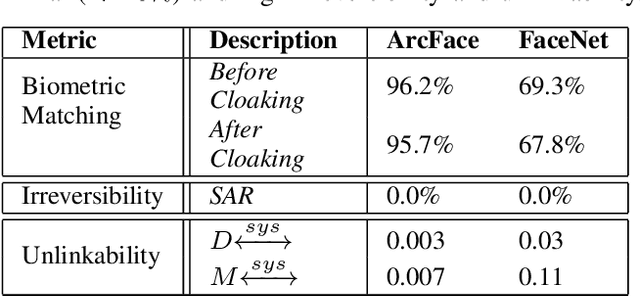
Abstract:Generative models can reconstruct face images from encoded representations (templates) bearing remarkable likeness to the original face raising security and privacy concerns. We present FaceCloak, a neural network framework that protects face templates by generating smart, renewable binary cloaks. Our method proactively thwarts inversion attacks by cloaking face templates with unique disruptors synthesized from a single face template on the fly while provably retaining biometric utility and unlinkability. Our cloaked templates can suppress sensitive attributes while generalizing to novel feature extraction schemes and outperforms leading baselines in terms of biometric matching and resiliency to reconstruction attacks. FaceCloak-based matching is extremely fast (inference time cost=0.28ms) and light-weight (0.57MB).
SEAL: Semantic Aware Image Watermarking
Mar 15, 2025Abstract:Generative models have rapidly evolved to generate realistic outputs. However, their synthetic outputs increasingly challenge the clear distinction between natural and AI-generated content, necessitating robust watermarking techniques. Watermarks are typically expected to preserve the integrity of the target image, withstand removal attempts, and prevent unauthorized replication onto unrelated images. To address this need, recent methods embed persistent watermarks into images produced by diffusion models using the initial noise. Yet, to do so, they either distort the distribution of generated images or rely on searching through a long dictionary of used keys for detection. In this paper, we propose a novel watermarking method that embeds semantic information about the generated image directly into the watermark, enabling a distortion-free watermark that can be verified without requiring a database of key patterns. Instead, the key pattern can be inferred from the semantic embedding of the image using locality-sensitive hashing. Furthermore, conditioning the watermark detection on the original image content improves robustness against forgery attacks. To demonstrate that, we consider two largely overlooked attack strategies: (i) an attacker extracting the initial noise and generating a novel image with the same pattern; (ii) an attacker inserting an unrelated (potentially harmful) object into a watermarked image, possibly while preserving the watermark. We empirically validate our method's increased robustness to these attacks. Taken together, our results suggest that content-aware watermarks can mitigate risks arising from image-generative models.
Huff-LLM: End-to-End Lossless Compression for Efficient LLM Inference
Feb 02, 2025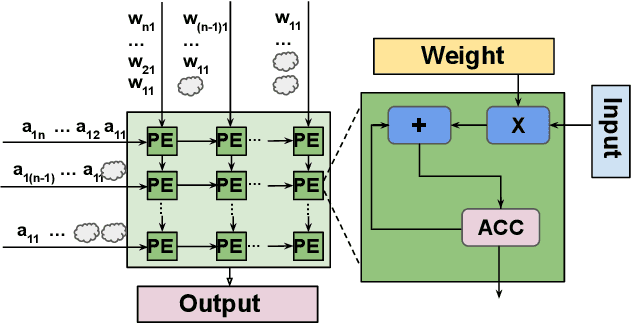
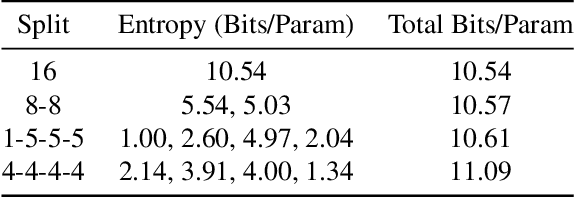
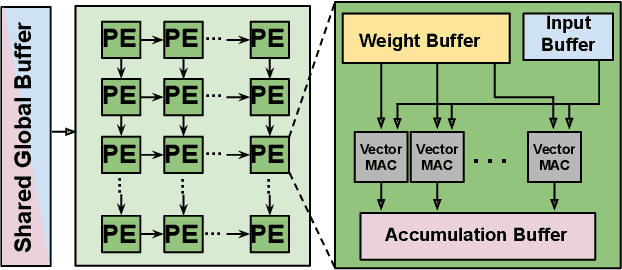
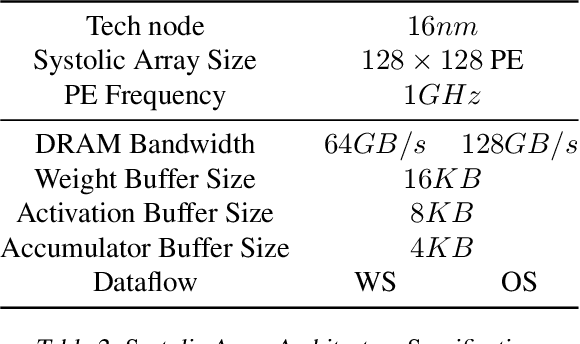
Abstract:As they become more capable, large language models (LLMs) have continued to rapidly increase in size. This has exacerbated the difficulty in running state of the art LLMs on small, edge devices. Standard techniques advocate solving this problem through lossy compression techniques such as quantization or pruning. However, such compression techniques are lossy, and have been shown to change model behavior in unpredictable manners. We propose Huff-LLM, an \emph{end-to-end, lossless} model compression method that lets users store LLM weights in compressed format \emph{everywhere} -- cloud, disk, main memory, and even in on-chip memory/buffers. This allows us to not only load larger models in main memory, but also reduces bandwidth required to load weights on chip, and makes more efficient use of on-chip weight buffers. In addition to the memory savings achieved via compression, we also show latency and energy efficiency improvements when performing inference with the compressed model.
RLS3: RL-Based Synthetic Sample Selection to Enhance Spatial Reasoning in Vision-Language Models for Indoor Autonomous Perception
Jan 31, 2025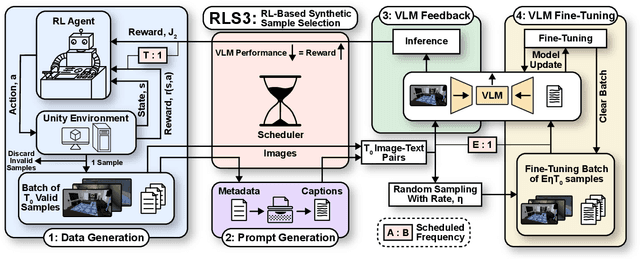
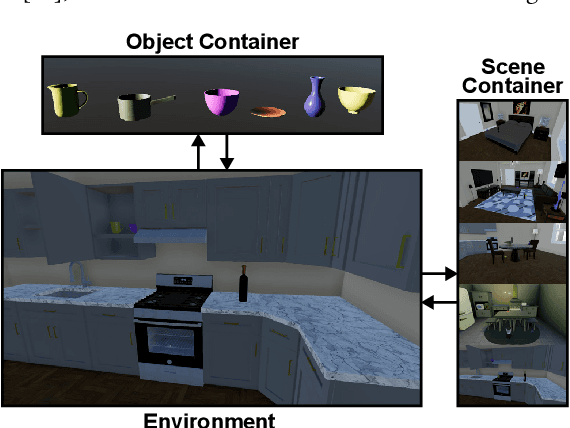
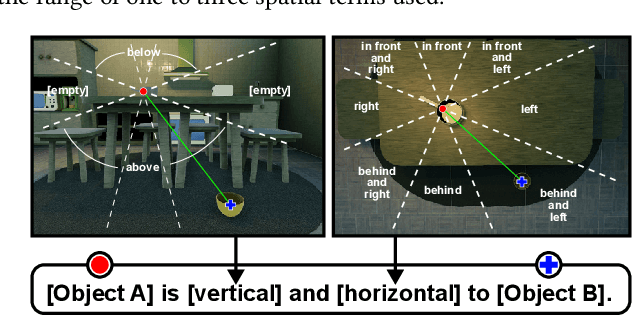
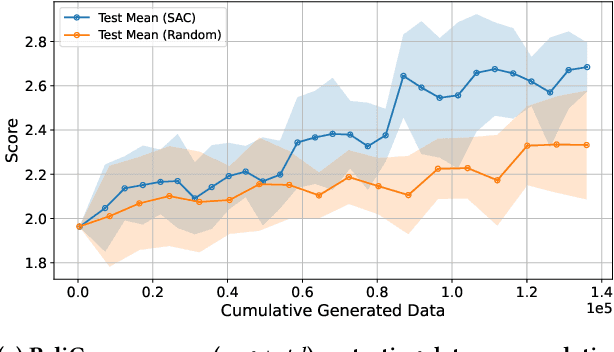
Abstract:Vision-language model (VLM) fine-tuning for application-specific visual grounding based on natural language instructions has become one of the most popular approaches for learning-enabled autonomous systems. However, such fine-tuning relies heavily on high-quality datasets to achieve successful performance in various downstream tasks. Additionally, VLMs often encounter limitations due to insufficient and imbalanced fine-tuning data. To address these issues, we propose a new generalizable framework to improve VLM fine-tuning by integrating it with a reinforcement learning (RL) agent. Our method utilizes the RL agent to manipulate objects within an indoor setting to create synthetic data for fine-tuning to address certain vulnerabilities of the VLM. Specifically, we use the performance of the VLM to provide feedback to the RL agent to generate informative data that efficiently fine-tune the VLM over the targeted task (e.g. spatial reasoning). The key contribution of this work is developing a framework where the RL agent serves as an informative data sampling tool and assists the VLM in order to enhance performance and address task-specific vulnerabilities. By targeting the data sampling process to address the weaknesses of the VLM, we can effectively train a more context-aware model. In addition, generating synthetic data allows us to have precise control over each scene and generate granular ground truth captions. Our results show that the proposed data generation approach improves the spatial reasoning performance of VLMs, which demonstrates the benefits of using RL-guided data generation in vision-language tasks.
 Add to Chrome
Add to Chrome Add to Firefox
Add to Firefox Add to Edge
Add to Edge